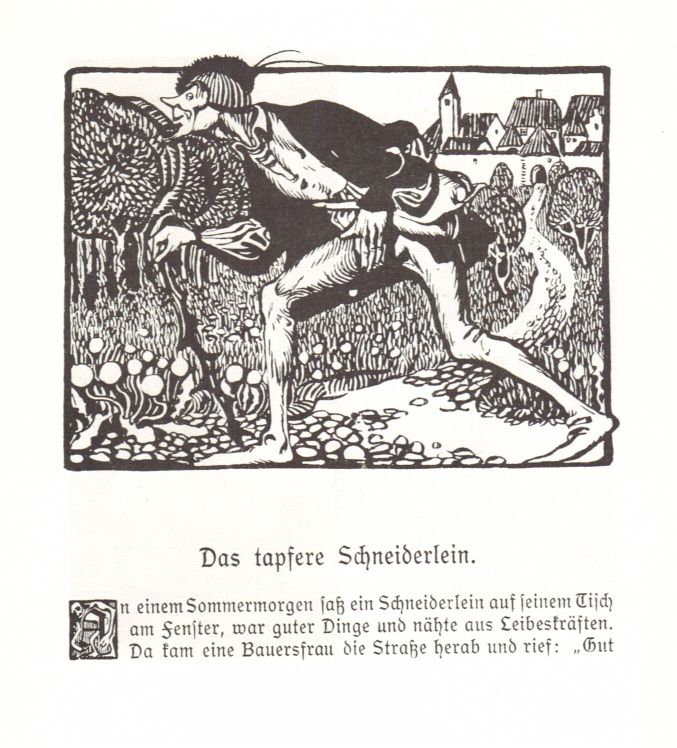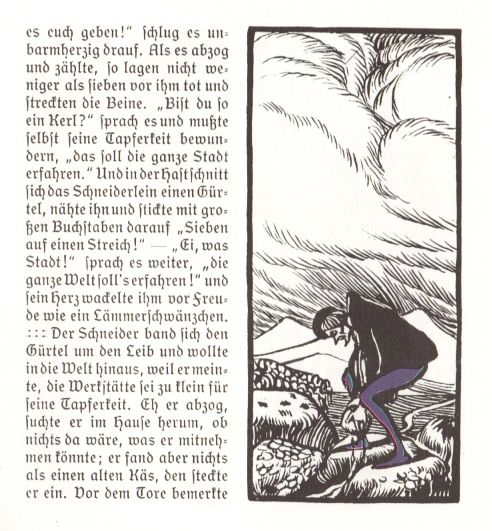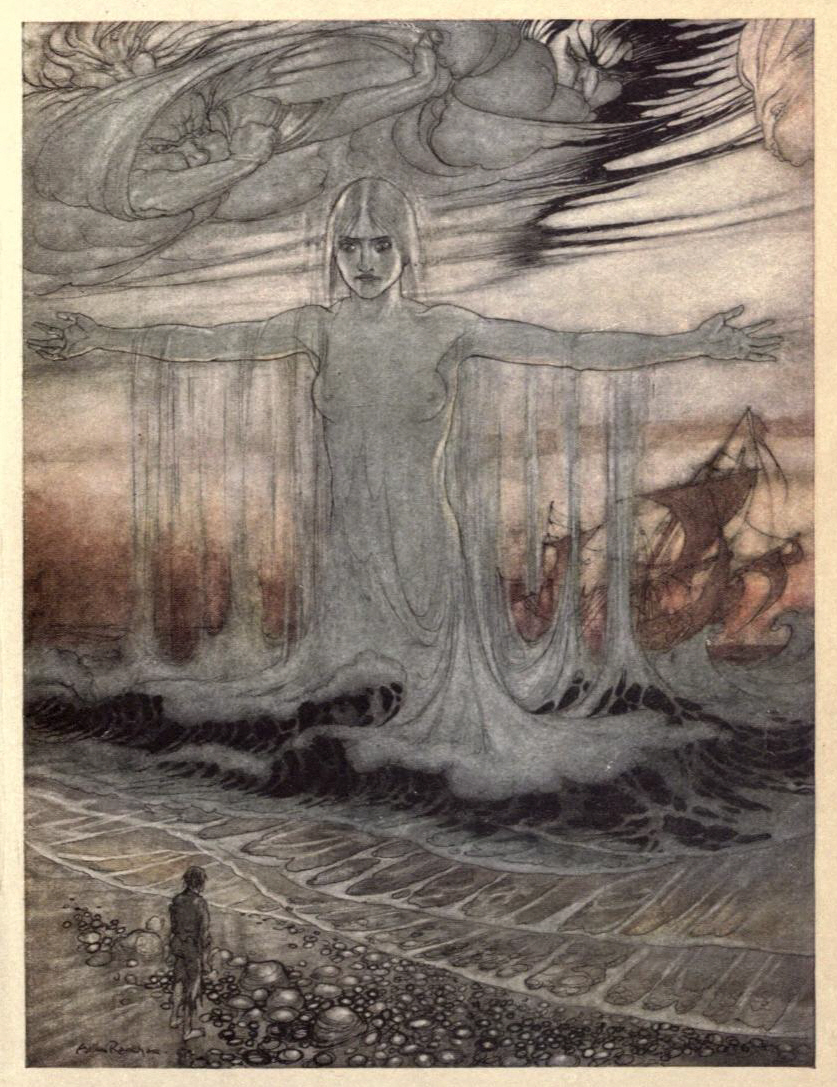THE MOON AND HER MOTHER
The Moon once begged her Mother to make her a gown. "How can I?" replied she; "there's no fitting your figure. At one time you're a New Moon, and at another you're a Full Moon; and between whiles you're neither one nor the other."
THE FIR-TREE AND THE BRAMBLE
A Fir-tree was boasting to a Bramble, and said, somewhat contemptuously, "You poor creature, you are of no use whatever. Now, look at me: I am useful for all sorts of things, particularly when men build houses; they can't do without me then." But the Bramble replied, "Ah, that's all very well: but you wait till they come with axes and saws to cut you down, and then you'll wish you were a Bramble and not a Fir."
This picture is actually a self-portrait of Arthur Rackham. If you pay attention you will find the artist in several illustrations.
THE CRAB AND HIS MOTHER
An Old Crab said to her son, "Why do you walk sideways like that, my son? You ought to walk straight." The Young Crab replied, "Show me how, dear mother, and I'll follow your example." The Old Crab tried, but tried in vain, and then saw how foolish she had been to find fault with her child.
Example is better than precept.
THE BLACKAMOOR
A Man once bought an Ethiopian slave, who had a black skin like all Ethiopians; but his new master thought his colour was due to his late owner's having neglected him, and that all he wanted was a good scrubbing. So he set to work with plenty of soap and hot water, and rubbed away at him with a will, but all to no purpose: his skin remained as black as ever, while the poor wretch all but died from the cold he caught.
THE QUACK FROG
Once upon a time a Frog came forth from his home in the marshes and proclaimed to all the world that he was a learned physician, skilled in drugs and able to cure all diseases. Among the crowd was a Fox, who called out, "You a doctor! Why, how can you set up to heal others when you cannot even cure your own lame legs and blotched and wrinkled skin?"
Physician, heal thyself.
THE SHIPWRECKED MAN AND THE SEA
A Shipwrecked Man cast up on the beach fell asleep after his struggle with the waves. When he woke up, he bitterly reproached the Sea for its treachery in enticing men with its smooth and smiling surface, and then, when they were well embarked, turning in fury upon them and sending both ship and sailors to destruction. The Sea arose in the form of a woman, and replied, "Lay not the blame on me, O sailor, but on the Winds. By nature I am as calm and safe as the land itself
THE TWO POTS
Two Pots, one of earthenware and the other of brass, were carried away down a river in flood. The Brazen Pot urged his companion to keep close by his side, and he would protect him. The other thanked him, but begged him not to come near him on any account: "For that," he said, "is just what I am most afraid of. One touch from you and I should be broken in pieces."
Equals make the best friends.
VENUS AND THE CAT
A Cat fell in love with a handsome young man, and begged the goddess Venus to change her into a woman. Venus was very gracious about it, and changed her at once into a beautiful maiden, whom the young man fell in love with at first sight and shortly afterwards married. One day Venus thought she would like to see whether the Cat had changed her habits as well as her form; so she let a mouse run loose in the room where they were. Forgetting everything, the young woman had no sooner seen the mouse than up she jumped and was after it like a shot: at which the goddess was so disgusted that she changed her back again into a Cat.
THE TRAVELLERS AND THE PLANE-TREE
Two Travellers were walking along a bare and dusty road in the heat of a summer's day. Coming presently to a Plane-tree, they joyfully turned aside to shelter from the burning rays of the sun in the deep shade of its spreading branches. As they rested, looking up into the tree, one of them remarked to his companion, "What a useless tree the Plane is! It bears no fruit and is of no service to man at all." The Plane-tree interrupted him with indignation. "You ungrateful creature!" it cried: "you come and take shelter under me from the scorching sun, and then, in the very act of enjoying the cool shade of my foliage, you abuse me and call me good for nothing!"
Many a service is met with ingratitude.
THE TREES AND THE AXE
A Woodman went into the forest and begged of the Trees the favour of a handle for his Axe. The principal Trees at once agreed to so modest a request, and unhesitatingly gave him a young ash sapling, out of which he fashioned the handle he desired. No sooner had he done so than he set to work to fell the noblest Trees in the wood. When they saw the use to which he was putting their gift, they cried, "Alas! alas! We are undone, but we are ourselves to blame. The little we gave has cost us all: had we not sacrificed the rights of the ash, we might ourselves have stood for ages."
THE LION, JUPITER, AND THE ELEPHANT
The Lion, for all his size and strength, and his sharp teeth and claws, is a coward in one thing: he can't bear the sound of a cock crowing, and runs away whenever he hears it. He complained bitterly to Jupiter for making him like that; but Jupiter said it wasn't his fault: he had done the best he could for him, and, considering this was his only failing, he ought to be well content. The Lion, however, wouldn't be comforted, and was so ashamed of his timidity that he wished he might die. In this state of mind, he met the Elephant and had a talk with him. He noticed that the great beast cocked up his ears all the time, as if he were listening for something, and he asked him why he did so. Just then a gnat came humming by, and the Elephant said, "Do you see that wretched little buzzing insect? I'm terribly afraid of its getting into my ear: if it once gets in, I'm dead and done for." The Lion's spirits rose at once when he heard this: "For," he said to himself, "if the Elephant, huge as he is, is afraid of a gnat, I needn't be so much ashamed of being afraid of a cock, who is ten thousand times bigger than a gnat."








THE GNAT AND THE LION
A Gnat once went up to a Lion and said, "I am not in the least afraid of you: I don't even allow that you are a match for me in strength. What does your strength amount to after all? That you can scratch with your claws and bite with your teeth—just like a woman in a temper—and nothing more. But I'm stronger than you: if you don't believe it, let us fight and see." So saying, the Gnat sounded his horn, and darted in and bit the Lion on the nose. When the Lion felt the sting, in his haste to crush him he scratched his nose badly, and made it bleed, but failed altogether to hurt the Gnat, which buzzed off in triumph, elated by its victory. Presently, however, it got entangled in a spider's web, and was caught and eaten by the spider, thus falling a prey to an insignificant insect after having triumphed over the King of the Beasts.











































































































